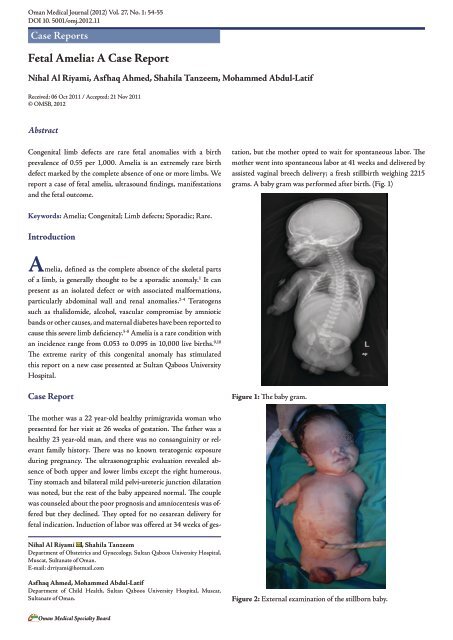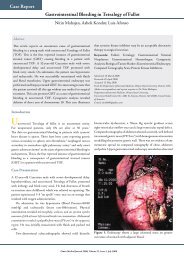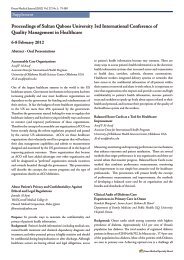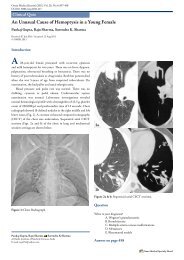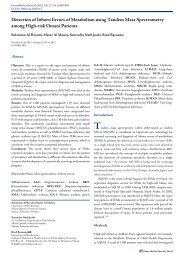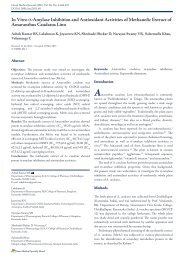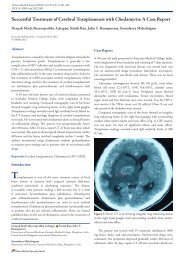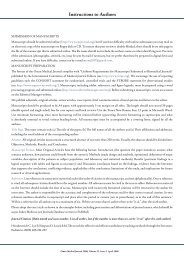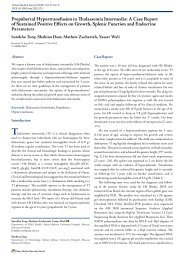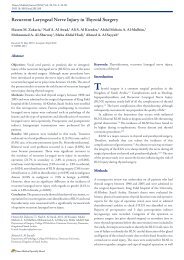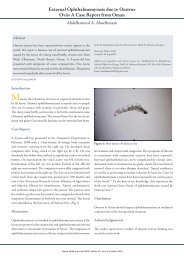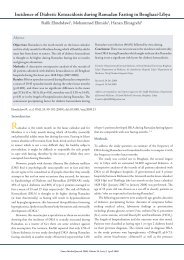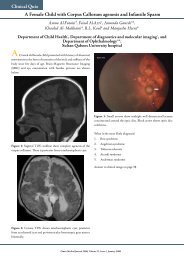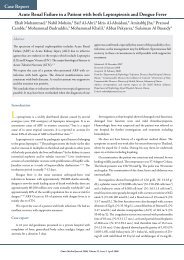Fetal Amelia: A Case Report - OMJ
Fetal Amelia: A Case Report - OMJ
Fetal Amelia: A Case Report - OMJ
Create successful ePaper yourself
Turn your PDF publications into a flip-book with our unique Google optimized e-Paper software.
Oman Medical Journal (2012) Vol. 27, No. 1: 54-55<br />
DOI 10. 5001/omj.2012.11<br />
<strong>Case</strong> <strong>Report</strong>s<br />
<strong>Fetal</strong> <strong>Amelia</strong>: A <strong>Case</strong> <strong>Report</strong><br />
Nihal Al Riyami, Asfhaq Ahmed, Shahila Tanzeem, Mohammed Abdul-Latif<br />
Received: 06 Oct 2011 / Accepted: 21 Nov 2011<br />
© OMSB, 2012<br />
Abstract<br />
Congenital limb defects are rare fetal anomalies with a birth<br />
prevalence of 0.55 per 1,000. <strong>Amelia</strong> is an extremely rare birth<br />
defect marked by the complete absence of one or more limbs. We<br />
report a case of fetal amelia, ultrasound findings, manifestations<br />
and the fetal outcome.<br />
The mother was a 22 year-old healthy primigravida woman who<br />
presented for her visit at 26 weeks of gestation. The father was a<br />
healthy 23 year-old man, and there was no consanguinity or relevant<br />
family history. There was no known teratogenic exposure<br />
during pregnancy. The ultrasonographic evaluation revealed absence<br />
of both upper and lower limbs except the right humerous.<br />
Tiny stomach and bilateral mild pelvi-ureteric junction dilatation<br />
was noted, but the rest of the baby appeared normal. The couple<br />
was counseled about the poor prognosis and amniocentesis was offered<br />
but they declined. They opted for no cesarean delivery for<br />
fetal indication. Induction of labor was offered at 34 weeks of gestation,<br />
but the mother opted to wait for spontaneous labor. The<br />
mother went into spontaneous labor at 41 weeks and delivered by<br />
assisted vaginal breech delivery; a fresh stillbirth weighing 2215<br />
grams. A baby gram was performed after birth. (Fig. 1)<br />
Keywords: <strong>Amelia</strong>; Congenital; Limb defects; Sporadic; Rare.<br />
Introduction<br />
<strong>Amelia</strong>, defined as the complete absence of the skeletal parts<br />
of a limb, is generally thought to be a sporadic anomaly. 1 It can<br />
present as an isolated defect or with associated malformations,<br />
particularly abdominal wall and renal anomalies. 2-4 Teratogens<br />
such as thalidomide, alcohol, vascular compromise by amniotic<br />
bands or other causes, and maternal diabetes have been reported to<br />
cause this severe limb deficiency. 5-8 <strong>Amelia</strong> is a rare condition with<br />
an incidence range from 0.053 to 0.095 in 10,000 live births. 9,10<br />
The extreme rarity of this congenital anomaly has stimulated<br />
this report on a new case presented at Sultan Qaboos University<br />
Hospital.<br />
<strong>Case</strong> <strong>Report</strong><br />
Figure 1: The baby gram.<br />
Nihal Al Riyami , Shahila Tanzeem<br />
Department of Obstetrics and Gynecology, Sultan Qaboos University Hospital,<br />
Muscat, Sultanate of Oman.<br />
E-mail: drriyami@hotmail.com<br />
Asfhaq Ahmed, Mohammed Abdul-Latif<br />
Department of Child Health, Sultan Qaboos University Hospital, Muscat,<br />
Sultanate of Oman.<br />
Figure 2: External examination of the stillborn baby.<br />
Oman Medical Specialty Board
Oman Medical Journal (2012) Vol. 27, No. 1: 54-55<br />
On clinical examination, there were no gross facial anomalies.<br />
Two lower limb buds and absent left upper limb was noted. The<br />
right upper limb was present up to the elbow with rudimentary<br />
palm/fingers attached to it and no forearm noted, (Fig. 2). Both<br />
testes were palpable; the anus and spine were normal. (Fig. 3)<br />
autopsy findings would have been helpful; but unfortunately,<br />
pathological examination and chromosomal analysis were refused<br />
by the parents. The current evidence on this topic is uncertain and<br />
the exact categorization of the condition is made more difficult by<br />
the absence of autopsy.<br />
The possibility of the recurrence of amelia has been<br />
documented in only a few families. 13-15 In this case, pregnancy and<br />
family history were non-contributory factors regarding genetic or<br />
teratogenic causes; maternal infection also appears to be unlikely.<br />
It is difficult to progress further in the etiology of this case. These<br />
parents were counseled for a low recurrence rate and advised to<br />
have an early anomaly scan in future pregnancies.<br />
Conclusions<br />
Prenatal diagnosis including detailed ultrasound and amniocentesis<br />
play a major role in counseling parents with fetal anomalies.<br />
Figure 3: Examination of the genital area of the stillborn baby.<br />
Discussion<br />
This report presents an infant with <strong>Amelia</strong> of three limbs and/<br />
phocomelia of one limb with no striking dysmporhic features<br />
noticed. The extreme rarity of this congenital anomaly has<br />
stimulated us to report this new case presented at our hospital.<br />
<strong>Amelia</strong> was traditionally thought to be a sporadic anomaly with<br />
little risk of recurrence, or evidence of genetic origins. However,<br />
different modes of inheritance has been involved in the etiology<br />
of <strong>Amelia</strong> including autosomal recessive, X linked dominant<br />
and autosomal mode of inheritance which indicate the genetic<br />
heterogeneity of this condition. 11<br />
This report describes a case of <strong>Amelia</strong> diagnosed in a<br />
pregnancy of a non-consanguineous couple, at 26 weeks prenatal<br />
scan. Clinical examination was consistent with the prenatal<br />
findings. <strong>Amelia</strong> with multiple malformations resembling Robert<br />
syndrome have been reported earlier by song et al. 12<br />
Although Robert syndrome, which is an autosomal recessive<br />
syndrome is considered as a single genetic entity and includes<br />
various morphologic defects; babies are being reported nowadays<br />
with severe facial defects, tetra-<strong>Amelia</strong>, and pulmonary<br />
abnormality, yet with normal chromosomal findings. 12 To the best<br />
of our knowledge; this is the first reported case of <strong>Amelia</strong> in the<br />
sultanate of Oman. However, <strong>Amelia</strong>, lung hypoplasia, and cleft<br />
lip palate were found to be transmitted in an autosomal recessive<br />
fashion in Arabs and Turkish families. 12<br />
In the current case; the prenatal ultrasound did not reveal gross<br />
anomalies apart from mild bilateral renal pelvis dilatation and the<br />
presence of a tiny stomach. Absent bowel gas noted on the skeletal<br />
survey after birth may have indicated a form of esophageal atresia.<br />
Infants with <strong>Amelia</strong> only appear to have good prognosis; whereas<br />
most newborns with <strong>Amelia</strong> associated with organ malformation<br />
die in the first year of life. As organ malformations have been<br />
reported to be frequently associated with cases of <strong>Amelia</strong>, 12<br />
Acknowledgements<br />
The authors reported no conflict of interest and no funding was<br />
received for this work.<br />
References<br />
1. Lenz W. Genetics and limb deficiencies. Clin Orthop Relat Res 1980<br />
May;(148):9-17.<br />
2. Froster-Iskenius UG, Baird PA. <strong>Amelia</strong>: incidence and associated defects in a<br />
large population. Teratology 1990 Jan;41(1):23-31.<br />
3. Evans JA, Vitez M, Czeizel A. Patterns of acrorenal malformation<br />
associations. Am J Med Genet 1992 Nov;44(4):413-419.<br />
4. Mastroiacovo P, Källén B, Knudsen LB, Lancaster PA, Castilla EE,<br />
Mutchinick O, et al. Absence of limbs and gross body wall defects: an<br />
epidemiological study of related rare malformation conditions. Teratology<br />
1992 Nov;46(5):455-464.<br />
5. Smithells RW, Newman CG. Recognition of thalidomide defects. J Med<br />
Genet 1992 Oct;29(10):716-723.<br />
6. Pauli RM, Feldman PF. Major limb malformations following intrauterine<br />
exposure to ethanol: two additional cases and literature review. Teratology<br />
1986 Jun;33(3):273-280.<br />
7. Van Allen MI, Curry C, Walden CE, Gallagher L, Patten RM. Limbbody<br />
wall complex: II. Limb and spine defects. Am J Med Genet 1987<br />
Nov;28(3):549-565.<br />
8. Bruyere HJ Jr, Viseskul C, Opitz JM, Langer LO Jr, Ishikawa S, Gilbert<br />
EF. A fetus with upper limb amelia, “caudal regression” and Dandy-Walker<br />
defect with an insulin-dependent diabetic mother. Eur J Pediatr 1980<br />
Aug;134(2):139-143.<br />
9. Bod M, Czeizel A, Lenz W. Incidence at birth of different types of limb<br />
reduction abnormalities in Hungary 1975-1977. Hum Genet 1983;65(1):27-<br />
33.<br />
10. Källén B, Rahmani TM, Winberg J. Infants with congenital limb reduction<br />
registered in the Swedish Register of Congenital Malformations. Teratology<br />
1984 Feb;29(1):73-85.<br />
11. Morey MA, Higgins RR. Ectro-amelia syndrome associated with an<br />
interstitial deletion of 7q. Am J Med Genet 1990 Jan;35(1):95-99.<br />
12. Song SY, Chi JG. Tri-amelia and phocomelia with multiple malformations<br />
resembling Roberts syndrome in a fetus: is it a variant or a new syndrome?<br />
Clin Genet 1996 Dec;50(6):502-504.<br />
13. Zimmer EZ, Taub E, Sova Y, Divon MY, Pery M, Peretz BA. Tetra-amelia<br />
with multiple malformations in six male fetuses of one kindred. Eur J Pediatr<br />
1985 Nov;144(4):412-414.<br />
14. Gershoni-Baruch R, Drugan A, Bronshtein M, Zimmer EZ. Roberts<br />
syndrome or “X-linked amelia”? Am J Med Genet 1990 Dec;37(4):569-572.<br />
15. Rodríguez JI, Palacios J, Urioste M, Rodríguez-Peralto JL. Tetra-phocomelia<br />
with multiple malformations: X-linked amelia, or Roberts syndrome, or DKphocomelia<br />
syndrome? Am J Med Genet 1992 Jun;43(3):630-632.<br />
Oman Medical Specialty Board


